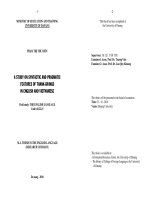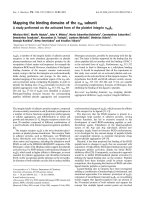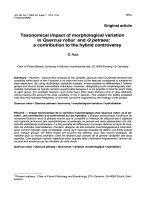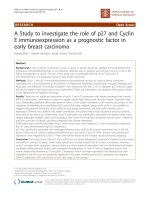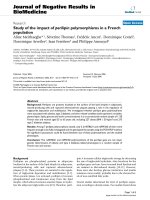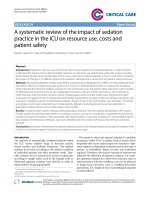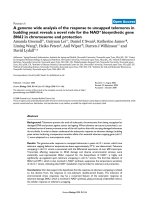A study to assess the potential impact of voluntary partnership agreement vpa to the livelihood of local people in dong xa commune na ri district bac kan province
Bạn đang xem bản rút gọn của tài liệu. Xem và tải ngay bản đầy đủ của tài liệu tại đây (2.16 MB, 73 trang )
THAI NGUYEN UNIVERSITY
UNIVERSITY OF AGRICULTURE AND FORESTRY
DUONG THI NHUNG
ASSESSING THE POTENTIAL IMPACT OF VOLUNTARY PARTNERSHIP
AGREEMENT (VPA) TO THE LIVELIHOOD OF LOCAL PEOPLE IN DONG
XA COMMUNE, NA RI DISTRICT, BAC KAN PROVINCE
BACHELOR THESIS
Study Mode
: Full-time
Major
: Environmental Science and Management
Faculty
: International Training and Development Center
Batch
: 2011 – 2015
Thai Nguyen, September 2015
Thai Nguyen University of Agriculture and Forest
Degree Program
Bachelor of Environmental Science and Management
Student name
DUONG THI NHUNG
Student ID
DTN1153120010
Thesis Title
A study to assess the potential impact of Voluntary
Partnership Agreement (VPA) to the livelihood of local
people in Dong Xa commune, Na Ri district, Bac Kan
province.
Supervisor (s)
Assoc. Prof. Tran Thi Thu Ha
Abstract:
VPA / FLEGT are bilateral trade agreement signed by the EU with partner countries
exporting wood and wood products. Accordingly, national partners committed only exports to
the EU wood and wood products illegal. National partners establish an assurance system to
verify the legality of timber and FLEGT licenses for wood and wood products will export to
the EU. For a mountainous commune like Dong Xa Commune, Na Ri District, the economic
life of people is more difficult, low educational levels, infrastructure such as roads,
schools, electricity from the national grid, and commune health stations, although the
State has done investment interest, but it remains difficult. The application of
regulations on forest and wood of the VPA will affect greatly to the life of people in
here. So, the main objective of the study was to assess the impacts of VPA the
livelihood of two groups of vulnerable communes in Dong Xa, which is : (1) smallscale woodworking households; (2) households having life dependent on the forest,
forest plantations in forest area due to the commune People's Committee of
Management but no legal papers, no forest land, or have very little forest land and
forest. Using interviewing people in ten villages of Dong Xa commune, surveys,
collect data on their income, the afforestation of households, analysis of interviewing
data, secondary data of Dong Xa, Na Ri district, found that: The vulnerability that
small-scale woodworking households encountered, such as: increased production costs
ii
from the price increase legal timber; increased transaction costs to achieve the legal
requirements for business registration and operation of enterprises; and vulnerable
because of changes in the market lead to changes in hiring (especially, the households
hire labor in outside). For households having life dependent on the forest, forest
plantations in forest area due to the commune People's Committee of Management but
no legal papers, no forest land, or have very little forest land and forest, they are
minorities and has a long tradition of sticking with their forests and livelihood depend
on forests. So, they are very vulnerable to changes in forestry regulations and access to
forest resources (including wood and non-wood products). Their source of income will
be reduced, due to difficulty selling timber to the outside with many regulations and
procedures.
Key words:
VPA, FLEGT, livelihood, forest, EU, illegal logging,
Number of pages:
56
Date of Submission:
September 30th, 2015
Supervisor (Sign)
iii
ACKNOWLEDGEMET
I would like to express my sincere gratitude to my research supervisor, Assoc.
Prof. Tran Thi Thu Ha, Director of Institute of Research and Development of Forestry,
Thai Nguyen University of Agriculture and Forestry, for supporting me all the way
through this thesis. Her invaluable encouragement interesting viewpoints and
constructive comments on this thesis have been highly appreciated. Therefore, I have
completed the project on time.
Further, I would like to sincerely thank the school administrator, ITC along
with teachers, the Department of Natural Resources and Environment, Department of
Agriculture and Rural Development of Bac Kan province, Forestry Department in Bac
Kan province, the relevant authorities of Na Ri and Dong Xa Commune People's
Committee with the enthusiastic help, were enthusiastically supported and created
favorable conditions, provided with full and correct data for me to finish my duties.
Finally, I would like to thank all my friends, my classmates, especially my
family for their great support.
During the internship, I tried very hard, but due to lack of experience and knowledge,
my thesis has unavoidably flawed. I would like to receive the heartfelt comments of
teachers and friends for my thesis were more complete.
I sincerely thank you!
Thai Nguyen, September 30th, 2015
The implementation
Duong Thi Nhung
iv
TABLE OF CONTENT
LIST OF FIGURES.............................................................................................................. 1
LIST OF TABLES ............................................................................................................... 2
LIST OF ABBREVIATIONS.............................................................................................. 3
PART I. INTRODUCTION................................................................................................. 4
1.1. Rationale.............................................................................................................. 4
1.2. Research objectives.............................................................................................. 6
1.3. Research question and hypotheses.......................................................................... 6
1.4. The limitations ..................................................................................................... 6
1.5. Research significance........................................................................................... 7
PART II. LITERATURE REVIEW .................................................................................... 8
2.1. The Voluntary Partnership Agreement .................................................................. 8
2.1.1. Definition of voluntary partnership agreement..................................................... 8
2.1.2. The Voluntary Partnership Agreement includes................................................... 9
2.1.3. Construction Voluntary Partnership Agreement................................................. 11
2.2.1. Definition of illegal wood .................................................................................. 18
2.2.2. Implementation the definition of legality of timber............................................ 19
2.3. Forest status in Vietnam...................................................................................... 20
2.3.1. Fluctuations in Vietnam forests...........................................................................20
2.3.2. The status and changes of forest in Bac Kan.......................................................22
PART III. METHODS ....................................................................................................... 30
3.1. Subject................................................................................................................ 30
3.2. Research design .................................................................................................. 30
3.3. Research contents ............................................................................................... 30
3.4. Research Methodology ....................................................................................... 31
3.4.1. Data collection methods...................................................................................... 31
3.4.2. Fieldwork Methods..............................................................................................31
3.4.3. Data processing methods.....................................................................................32
3.4.4. Experts Consultation........................................................................................... 32
v
PART IV. RESULTS......................................................................................................... 33
4.1. Current status of forest land allocation in Dong Xa Commune............................ 33
4.2. Small-scale woodworking households................................................................. 35
4.2.1. The main characteristic of small-scale woodworking households......................35
4.2.2. Some impacts of VPA to small-scale woodworking households........................41
4.3. Households having life dependent on the forest and forest plantations in forest
area due to the commune’s People's Committee of Management but no legal papers . 43
4.3.1. The main characteristics of the study group........................................................43
4.3.2. The issues that research target group encountered and the impact of the VPA 46
PART V. DISCUSSION AND CONCLUSION ............................................................... 51
5.1. Discussion .......................................................................................................... 51
5.2. Conclusion.......................................................................................................... 52
REFERENCES................................................................................................................... 54
vi
LIST OF FIGURES
Figure 2.1. Organizational structure of FLEGT/VPA 4negotiation of Vietnam .....15
Figure 2.2. Forest coverage rate over the years of Bac Kan Province.......................... 24
Figure 4.1. Bac Kan province map - Na Ri location purple blue.................................. 33
1
LIST OF TABLES
Table 2.1: The variation in forest area Vietnam during 1943-2012 (million
hectares) ..................................................................................................20
Table 2.2. Structure of forest types........................................................................ 21
Table 2.3. The area of forest land according three forest types through the years
2011 – 2014........................................................................................... 23
Table 2.4. Afforestation area through the years 2011-2014....................................24
Table 2.5. The percentage of forest cover over the years 2011-2014......................24
Table 2.6. The percentage of forest cover in the districts, towns............................25
Table 4.1. Data consolidation: Planning of forest land in the district in 20102013.......................................................................................................34
Table 4.2. Current status of forestland allocation in Dong Xa Commune...............35
Table 4.3. Interviewing information of small-scale woodworking households.......36
Table 4.4. Production method, income of small-scale woodworking households... 37
Table 4.5. The procedure of the production process wood and wood products.......38
Table 4.6. Interviewing information of households having life dependent on the
forest......................................................................................................44
Table 4.7. The income of households having life dependent on the forest and forest
plantations in forest area........................................................................45
2
LIST OF ABBREVIATIONS
Abbreviations
The meaning
CPC
Commune people’s committee
CSOs
Civil society organizations
DPC
District people’s committee
EU
The European Union
EUTR 995
EU Timber Regulation
FLEGT
Forest law enforcement, Government and Trade
IFAD
International foundation agriculture development
LD
Legality definition
MARD
Ministry of Agriculture and rural development
SRD
Sustainable rural development
TLAS
Timber legality assurance system
TWG
Team working group
VNGO-FLEGT
The Vietnamese Non-government organization’s network on
forest law enforcement, government and trade
VNTLAS
Vietnam Timber legality assurance system
VPA
Voluntary partnership agreement
3
PART I. INTRODUCTION
1.1. Rationale
The topography of the country in majority area of hills, but mainly low hills
and mountainous terrains accounts for three quarters of the territory. The terrain with
elevations below 1000m up 85% of the area is mainly distributed in the North and
West territory, on the 2000m high terrain only accounts for 1%. The area of forest land
in our country in 2005 was 14.43 million hectares, accounting for 43.6% of the natural
land. With varied terrain, tropical climate has changed from North to South, it has
created a diversity of natural ecosystems and the abundance of the species. These
ecosystems include many forest types such as many broad-leaved evergreen forests,
semi-deciduous forest, deciduous forest, limestone forest, mixed forest of coniferous
and broadleaved, coniferous forest, bamboo forest, mangroves, mangrove forests, and
freshwater wetland forest. However, in recent years due to overexploitation of human,
natural disasters and forest fires, resources of Vietnam were severely reduced in both
quantity and quality of forests. (Thuong, 2005).
From 11/2010, Vietnam and the European Union (EU) have announced
negotiations Voluntary Partnership Agreement (VPA) on strengthening forest law
enforcement, governance of forests and forest products trade (FLEGT). Currently,
both sides are in the final stages of the negotiation process. Research
project:“Assessing the potential impact of Voluntary partnership agreement (VPA)
to the livelihood of local people in Dong Xa commune, Na Ri district, Bac Kan
province” to provide a portion of the results and put forecasting situations of two
groups of vulnerable: small-scale woodworking households and households having life
dependent on the forest, forest plantations in forest area due to the commune People's
4
Committee of Management but no legal papers can be affected on how the VPA
agreement is signed.
Voluntary Partnership Agreements (VPAs), and the processes through which
they are developed, have considerable potential to bring about pro-poor policy
reforms and can result in the empowerment of the more vulnerable community
groups. With the implementation of the VPA, the timber production and processing
industry has to adapt to changing market demands and export regulations, and an
action plan to ensure timber legality is required by Vietnam. This action plan has to
focus on raising awareness, amending ad reviewing legislation, encouraging
enterprise to import certified timber, developing and implementing a timber legality
assurance system, and strengthening international cooperation with export countries
such as Laos and Cambodia and with markets in EU countries. (FLEGT, 2003).
Dong Xa Commune, Na Ri district is a mountainous commune, located in the
northeast province of Bac Kan. The economic life of people is more difficult, low
educational levels, infrastructure such as roads, schools, electricity from the national
grid, and commune health stations, although the State has done investment interest
remains difficult.
To learn about the issues in the framework of a thesis, the consent of
International Training and Development Center, under the guidance of teacher Assoc.
Prof. Dr. Tran Thi Thu Ha, I conducted research topic: “Assessing the potential
impact of Voluntary partnership agreement (VPA) to the livelihood of local people
in Dong Xa commune, Na Ri district, Bac Kan province”.
5
1.2. Research objectives
+) General objectives
This study aims to assess and investigate the situation prediction about the effect
of VPA on the livelihood of people, these groups are vulnerable: small-scale
woodworking households, and households having life dependent on the forest, forest
plantations in forest area due to the commune People's Committee of Management but
no legal papers in Dong Xa Commune, Na Ri district, Bac Kan province.
+) Specific objectives
- Survey the understanding / awareness of the people / communities on the
legality of timber and timber products.
- Analysis forestry law enforcement and its impact on benefits and obligations
of the people / communities.
- Synthesis of aspirations / suggestions of the people related to ensuring the
legality of timber and timber products associated with improved livelihood. Then, find
the negatives that people can be affected when VPA was signed.
1.3. Research question and hypotheses
What are the current states of management of the exploitation and
protection of forests in the Na Ri district, Bac Kan province?
What are the characteristics of the livelihood of households?
What are the effects of VPA to the livelihood of local people?
1.4. The limitations
The restrictions during the research process include distance, the mountain roads
are craggy, the local people were not cooperating in the interview process, lack of
means of transportation, and lack of practical experience.
6
1.5. Research significance
+) The significance of the study and scientific research:
- Applying the knowledge gained from school into reality;
- Improving practical skill;
- Accumulation work experience after graduation;
- Advanced knowledge of study and get to reference materials to achieve the effect.
+) Reality significance:
Review of the management, protection, status logging and forest product use in
Dong Xa Commune sector.
Making predictions about the situation of the VPA impact on the livelihood of
people in the commune, namely two groups of subjects were identified as vulnerable:
Small-scale woodworking households, and households having life dependent on
the forest, forest plantations in forest area due to the commune People's
Committee of Management but no legal papers.
Raising the awareness of local people about environmental issues and the
legal logging.
7
PART II. LITERATURE REVIEW
2.1. The Voluntary Partnership Agreement
2.1.1. Definition of voluntary partnership agreement
FLEGT Action Plan of the EU recognizes that as a consumer market valued
wood products, the EU must share the responsibility with the producing nations of
woodworking to combat illegal logging and the related commercial activities.
However, at present there is no real mechanism to detect and eliminate illegal timber
from the EU market. (EU FLEGT, 2009).
+ What is FLEGT?
FLEGT is "Forest Law Enforcement, Governance and Trade in timber forests".
FLEGT Action Plan of the European Commission to include a program of activities of
the EU to deal with the problem of illegal logging and trading activities of timber
products related to illegal timber. (EU FLEGT, 2009).
Therefore, the Action Plan FLEGT of the EU launched an initiative to build the
Voluntary Partnership Agreement (VPA) between the EU and timber producing
countries (FLEGT partner countries). The Agreement is designed to eliminate
essentially illegal timber production from domestic commercial activities as well as a
country's international partners.
The Voluntary Partnership Agreement is a binding agreement between the EU
and the partner countries in which the two sides committed to working closely together
to support the objectives of the FLEGT Action Plan and enforce licensing
mechanisms. To create conditions for this cooperation, a new EU regulation for the
implementation of the FLEGT licensing scheme was adopted. (FLEGT, 2003).
8
2.1.2. The Voluntary Partnership Agreement includes
VPA aims to support the commitment of the timber producing nations (partner
countries) to promote sustainable forest management through support to these
countries to improve forest law enforcement and governance forest.
One factor common to all the VPA is the partner country committed or will commit to
building mechanisms law and administrative reliable as well as technical systems to
verify that timber products made according to the provisions of national law partner.
(FLEGT, 2003). That include:
- A commitment to ensure that forestry laws concerning consistent,
understandable,
enforceable
and
effective
promotion
of
sustainable
forest
management.
- The development of administrative systems and techniques to monitor the
exploitation activities, identification and traceability of wood from the place of
extraction to the market or export assembly point.
- Commitment to improve transparency and the accountability in forest
governance.
- Establishing control and counterbalance in the system traceability of timber
and timber license, including the implementation of a system of independent
monitoring.
- Develop processes for export licenses were legally harvested timber.
- Construction licensing processes for export legally harvested timber.
VPA was applied to forestry and forest governance in each partner country is
different. Therefore, in each partner country, Voluntary Partnership Agreement to take
into account factors such as: The issues of national forest governance; building work
9
of forest laws; the nature of land use rights and forest; the nature of the timber trade;
current initiatives of the forestry sector as well as the capacity to implement the
agreement to be signed. (FLEGT, 2003).
These factors should be considered when designing and implementing the Voluntary
Partnership Agreement:
- Social Security: Voluntary Partnership Agreement should seek to minimize
the negative impact on local communities and the poor on the basis of adequate
attention to the livelihood of forest-related communities local and indigenous people.
The partner countries are encouraged to link FLEGT issues with poverty reduction
strategies and monitoring the impact of the VPA on poverty.
- The involvement of the components: There should be provisions must
regularly consult the stakeholders in the process of designing and implementing the
Agreement VPA. This should include also the way to create conditions for the private
sector participation in efforts to combat illegal logging, but also have to ensure that
these requirements are incorporated into the Agreement does not create additional
burdens excessively heavy for small producers.
In some partner countries, satisfy the above requirements will require tremendous
efforts for capacity building and institutional strengthening. VPA must clearly identify
fields to be supported financially as well as engineering. Any assistance will be geared
towards the strengthening of legality in the forestry field. That is the fundamental step
towards achieving the sustainable management of forest resources. Fields that need
attention include:
- Supporting timber production nationally;
- Encouraging the legal timber trade;
10
- Encouraging enforcement policies and purchase legal timber products from
legal timber processing;
- Supporting the initiatives of the private sector;
- Ensuring safety for financial operations and investments;
- Using existing law instruments or enact new legal tools to support the action plan;
- Dealing with the problem of timber but also controversy. (DFID, 2013).
2.1.3. Construction Voluntary Partnership Agreement
2.1.3.1. Negotiation and Validity of Agreement
The Voluntary Partnership Agreement is launched from the unofficial
discussions between the EU and partner countries in the future, usually by the
European Commission or one or more member states of the EU implementation. That
will ensure that all stakeholders in partner countries understand the goals of the VPA
as well as mechanisms for implementation of the Agreement; it also helps the EU to
understand the internal problems in the forestry sector of partner countries that should
be addressed in the design process of the Agreement. Future partner countries will
notify the European Commission when they are ready for the formal negotiations.
(Journal of Wood Vietnam, 2014).
The negotiation will focus on important issues that affect the enforcement of
forestry laws and forest governments of partner countries. The negotiating process
may take several months.
VPA will take effect when the negotiation process ended and the administrative
procedures of each side are completed (e.g: the agreement ratifies).
2.1.3.2. Joint Implementation Committee
11
Joint Implementation Committee (JIC) will be established with representatives
from partner countries, the European Commission and the EU Member States, the
Committee are responsible for ensuring that discussions between the EU and partner
countries take place regularly and have effected. The Commission will facilitate,
monitor and supervise the implementation of the Agreement at the same time
arrangements and settle all disputes or conflicts arise. (VNGO-FLEGT, 2014). The
tasks of the Committee include:
- Decision effective time of the licensing mechanism.
- Monitoring and assessment overall progress of the implementation of
Voluntary Partnership Agreement.
- Review the reports of the independent monitoring bodies as well as complaints
about the operation of the licensing mechanism.
- Making the mediator and resolve conflicts / disputes relating to the Agreement
and licensing mechanism.
2.1.3.3. Planning and implementation
Each VPA contains a detailed plan that clearly states activities, the time taken
to improve governance in the forestry sector and implementation of the licensing
mechanism.
Depending on the degree of readiness of each partner country, also after VPA
effective for some time, the new licensing mechanism operated by the possible need to
build or strengthen the Timber Legality Assurance System (TLAS). As a partner
country for that the Timber Legality Assurance System of their country has satisfied
all the requirements, national partners will inform the EU through the JIC. (Thuy, 2008).
12
After confirming that information, the European Commission will take the
name of the partner country and any additional products that will be controlled by a
licensing mechanism in the Appendices of the Regulation FLEGT of the EU. From
this time onwards, all the product relevant partner countries exporting to the EU will
be forced to have a FLEGT license. (Thuy, 2008).
2.1.3.4. Assessment and Reporting
They will have to prepare an annual report on the situation development and
implementation of the VPA. These reports will be presented in detail to complete the
objectives and actions agreed the scheduled of implementation, as well as the progress
in eliminating the situation of illegal timber being exported to markets outside the EU
or domestic markets. When licensing mechanism comes into operation, the report will
give details of how many licenses have been issued and how much is the volume of
timber exported to the EU market. (Andy Roby, 2013).
The VPA contains provisions to evaluate the effectiveness and impact of the
agreement. First evaluation will be carried out immediately after the start of
implementation of the agreement is two years. However, during the two years that if
any problems arise in the process implementation of the Agreement, it could still
organize unscheduled evaluation.
2.1.3.5. The benefits that partner countries receive from the VPA
Those that would like to make the VPA and licensing mechanism, they need to
build capacity and investments in order to ensure credit-worthiness. In return, the
partner countries will also receive the following benefits:
- Be strengthened political and financial resources to implement the reforms of
the Government in field strengthening forest governance.
13
- Improving access condition the EU market for private procurement policies
and the EU public is increasingly encourage only purchase and sales and use legal
timber and exclude the wood of unknown origin or illegal. Thus, all kinds of products
allowed to be imported into the EU market are considered legitimate origin.
- Increased budget revenue from tax sources that in some cases this revenue will
even bigger operating costs licensing system.
- Increased budget revenue to expenses for poverty alleviation and community
development programs.
- Get EU development aid priority to proceed with the measures relating
to FLEGT.
- Having additional enforcement tools to prevent illegal activities.
- Facilitating the development of private enterprises towards certified
sustainable forest management.
- To improve its image in the international arena by the Government's
commitment to strive for good governance. (Thuy, 2008).
Trade activities with countries choosing not to participate Voluntary Partnership
Agreement ahead will not be affected. However, as more and more countries adopt
policies to encourage procurement wood / wood products were verified as legitimate,
the countries have problems of illegal logging and choose not to participate Agreement
voluntary partnership will certainly be reduced the market share trade to the EU. (EU
FLEGT, 2009).
14
2.2. Organizational structure of FLEGT/VPA negotiation of Vietnam
Figure 2.1. Organizational structure of FLEGT/VPA negotiation of Vietnam
With wood products accounting for 80% of export products of Vietnam, and
Forest Law Enforcement, Governance and Trade Forest Products (FLEGT), the EU
has set requirements for wood legality and timber products imported into the EU.
Vietnam and the EU have formal negotiations on FLEGT / VPA since
November 2010. Vietnam is expected to complete negotiations in 2015. The agency in
charge of negotiating FLEGT / VPA in Vietnam's Ministry of Agriculture and Rural
Development (MARD). MARD in collaboration with other ministries including the
Ministry of Foreign Affairs, Ministry of Justice, Ministry of Commerce, Ministry of
Finance, the Association of Woodworking and trade Towards EU, the lead agency is
the General Department of Environment,belonging to the EU delegation in Brussels,
15
Belgium with technical assistance from experts from the European Forest Institute
(EFI). (Vũ, 2012).
From May 20 to October 24, 2014 in Hanoi, Vietnam and the EU have
conducted sessions 8th about technical grade and high-level negotiations 4th about
Voluntary Partnership Agreement on forest Law enforcement, Governance and Trade
of forest products (referred to as the VPA / FLEGT). Vietnam's negotiation delegation
led by Mr. Cao Chi Cong, Deputy General Director of the General Directorate of
Forestry, Ministry of Agriculture and Rural Development of Vietnam is the director
and members from the Ministries of Agriculture and Rural Development, Industry and
Commerce, General Administration of Customs (Ministry of Finance), Foreign
Affairs, Justice and the Association of Vietnam timber and Forest Products. An EU
negotiation team led by Mrs. Astrid Schomaker, Head of Global Sustainability, Trade
and multilateral agreements, Directorate General Environment, the European
Commission is the director and members of the EU Delegation in Vietnam,
representative the Embassy of Germany and Finland in Vietnam and the experts of the
European Forest Institute. (Vũ, 2012).
The government of Vietnam and the European Union (EU) began negotiations
towards signing the Voluntary Partnership Agreement on Forest Law Enforcement,
Governance and Trade Forest Products (VPA / FLEGT) from last year 2010 with the
aim to ensure that timber and timber products exported from Vietnam to the EU
member states have legal backgrounds. Accordingly, when the agreement takes effect,
Vietnam committed to apply a system of timber legality assurance and FLEGT
licensing certify the legality of timber and timber products from Vietnam to export to
EU market. Wood and wood products of Vietnam FLEGT licensed will not proceed
16
accountability for the source of the wood under the EU Timber Regulation (Regulation
EUTR 995) with effect from March 2013. (VNGO-FLEGT, 2014).
Since the start of negotiation, the two sides have conducted numerous technical
meetings to discuss the annexes of the Agreement, including the list of goods brought
into the agreement, the scope of the definition of legal timber, system to ensure legal
wood, publication of information and functions of the Joint implementation Committee.
The two sides have conducted seven meetings of the technical expert group and three
high-level negotiations to be held in Hanoi and Brussels. (EU FLEGT, 2009).
During the three days technical-level meetings and two days of high-level talks,
the two sides discussed and achieved many important progress on key issues,
including the list of goods brought into agreement, the scope the definition of legal
timber and Vietnam Timber legality Assurance system (VNTLAS) and publication of
information.
In high-level negotiations 4th, the two sides once again confirmed their
commitment to the principles set out for the Agreement and will conduct further
technical discussions on the issue have not agreed in next time. The two sides agreed
on a roadmap for the remaining stages of the negotiation process with the goal of
concluding the negotiation in late 2015. (Thuy, 2008).
During the last negotiation session, the two sides held a press conference and
meeting with the stakeholders to inform the negotiation results. More than 40
organizations representing wood processing the business sector, non-governmental
organizations Vietnam and international and the media, attended the press conference.
In 2003, the EU through the Action Plan on Forest Law Enforcement,
Governance and Trade Forest Products (FLEGT) to address the problem logging and
17
illegal trade. October 20th, 2010, the National Assembly and the EU Commission
issued Regulation 995/2010 imposes the obligation of the exporter of timber and
timber products into the EU market. The regulations take effect from March 3, 2013.
(EU FLEGT, 2009).
Currently, there are six countries signed a VPA with the EU, including
Indonesia, Ghana, Cameroon, Liberia, Republic of Congo and Central African
Republic, and these countries are conducting constructive systems to test, verified,
licensing wood and wood products legal. The countries above are called "the partner
countries of VPA". Nine other countries, including Vietnam, Laos, Thailand and
Malaysia, are conducting negotiations with the EU and 11 other countries in Africa,
Asia, Central and South America have expressed concern for VPA. (Rights and
Resources Initiative, 2014).
2.2.1. Definition of illegal wood
2.2.1.1. The basis
The FLEGT action plan of the EU, identifying measures to resolve the situation
exploitation and illegal timber trade is increasing. Fundamental to the implementation
of such measures is the ability to differentiate between legal timber and illegal timber.
A definition of the legality of the wood will be important factors in the timber legality
assurance system is part of the Voluntary Partnership Agreement (VPA) will be
negotiated between the EU and timber producing countries. (VNGO – FLEGT, 2014).
18
2.2.1.2. Construction definition of legality of timber
The process to decide what the law is included in the definition belong the
responsibilities of countries that apply the laws. If the definition is an element in the timber
legality assurance system to support trade agreements, it has to be on the national
government to apply the law endorsed. However, the nature of this process is the definition
for the legality of timber must be the different sectors involved in social recognition.
The potential risk due to non-compliance can create different effects on
different components in wood-producing countries, such as government, private
sector, communities, ethnic or local. Therefore, the construction process definition
must be consulted all relevant sectors of society. In countries where the law is uniform
and clearly, then defined building will not complex. For asynchronous law countries,
overlap and conflict, it will be a very difficult task, to refer multiple times, and to test
in practice defines whether it is suitable or not. (Callister, 1992).
The above are some examples of reference process to determine what law is
inconsistent with the demand for sustainable forest management, or where there are
important rights are not recognized by law. In these cases the need to apply a
temporary definition, possible to bring the best effect in the law reform process.
2.2.2. Implementation the definition of legality of timber
To check the compliance of rules defining and implementing it requires the
definition should be clear, be feasible and verifiable objectives. The definition must
also understand for forestry workers as well as for law enforcement. It means:
- The law or regulation should be dropped or not been included in the
definition should be clear;
19


